Venomous Animals
Did you know that...?
A venomous animal differs from a poisonous animal with the simple fact that a venomous animal has a specialised delivery system for injecting the venom it produces. Whereas, a poisonous creature does not have this mechanism but the poison is present, either throughout the body or in certain areas. The poison may be delivered if the creature is eaten or touched. Puffer fishes and poison arrow frogs are both poisonous, while snakes, scorpion and bees are venomous.Snakes
Prevention of Bites
Some precautions can be adopted to reduce the unfortunate encounters with snakes and consequent bites:
- It is advised that you get to know the local venomous snakes, which places they like to hide and what time of day and year they are more likely seen. (eg At nights, during rainy season).
- Snakes are often hesitant to tackle larger animals like us humans, therefore, if a snake is spotted, kindly allow it to slither away and leave them to their routine, rather than having it meet a violent death with the cutting edge of a machete blade, as is customary in Trinidad. In general; snakes should not be handled unless you have been properly trained to do so.
- If you encounter a snake that is presumed to be dead, be careful if you are about to handle it, at times, a scratch by the fangs of the snake may be enough to allow venom to be injected into the body.
- As much as possible, keep the snake’s food source out of your home, this will include creatures such as mice, rats and poultry (many snakes consume eggs). Snakes would come around if food is in abundance.
- Avoid having too much debris around your home; this would include keeping the grass around your surroundings a short length.
- Be wary of snakes being washed down by rains and may be present in flood waters. Certain snakes are excellent swimmers and with murky flood waters, it will be difficult to spot them.
Venomous Snakes in Trinidad
There are more than sixty species of snakes in Trinidad and Tobago. Trinidad has four venomous species. There are no venomous snakes in Tobago.
The four species are the two Mapipire Snakes and the two types of Coral snakes.
Mapepire Snakes
- Fer-de-lance aka Mapepire balsain( Bothrops atrox)
- Bushmaster aka Mapepire z’anana (Lachesis muta muta)
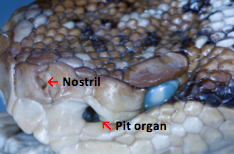 Photo showing the pit organ on the Lachesis muta muta (Bushmaster). Photo courtesy John C. Murphy
Photo showing the pit organ on the Lachesis muta muta (Bushmaster). Photo courtesy John C. Murphy
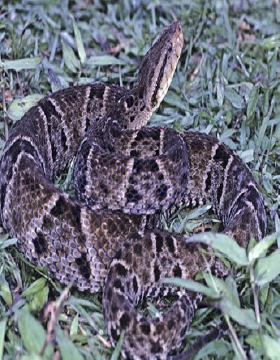 Photo courtesy John C. Murphy
Photo courtesy John C. MurphyMapepire Balsain (Fer de Lance)
Scientific Name: Bothrops atroxThese snakes are mostly found in forested areas in Trinidad. Their prey includes small rodents, frogs and birds.
They can grow up to two meters in length and are quite easily agitated.
Their venom consists of enzymes and heamatoxins, which are meant to assist in the digestion of their prey but if a human is bitten it will cause swelling and necrosis (rotting) of the affected area.
If bitten, SEEK IMMEDIATE MEDICAL ATTENTION!!
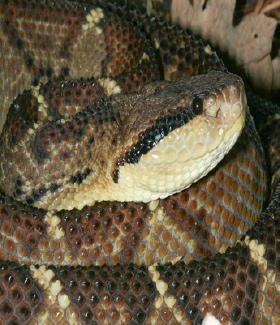 Photo courtesy John C. Murphy
Photo courtesy John C. MurphyMapepire Z’anana ( Bushmaster)
Scientific Name: Lachesis muta mutaThis is the world’s largest pit viper, it can grow to lengths of up to 4 meters. They live in isolated habitats. They mostly hunt at nights and are also extremely aggressive. Their fangs are long and would deliver venom deep within the area bitten. They are now becoming extremely rare in the wild.
Their venom is also made up of various enzymes and heamatoxins.
If bitten, SEEK IMMEDIATE MEDICAL ATTENTION!!
Did You Know That...?
The name of the mapepire Z’anana comes from the Amerindian word for pineapple. They found that the snake resembled a pineapple when curled up in the attack position.
Coral Snakes
These beautifully coloured snakes which are found in Trinidad are:
- Large Coral – Micrurus lemniscatus diutius
- Small Coral – Micrurus circinalis
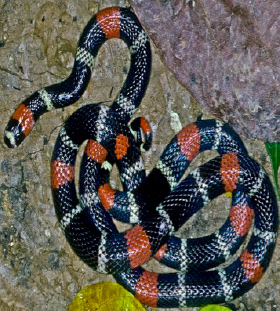
Large Coral
Scientific Name: Micrurus lemniscatus diutiusThese snakes may grow up to 50cm in length. They prefer to live in swamp like areas; there is some cannibalistic behaviour to these snakes. These snakes are normally aggressive.
Their venom consists of a powerful neurotoxin, which may cause respiratory collapse and paralysis in the worst case scenario.
If bitten, SEEK IMMEDIATE MEDICAL ATTENTION!!
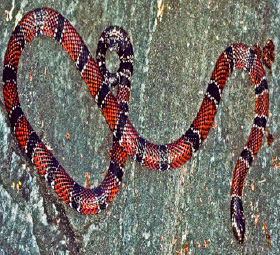
Small Coral
Scientific Name: Micrurus circinalis These snakes grow up to lengths of 50 cm in length. The behaviour of these snakes is similar to that of the large coral. Their venom also consists of a powerful neurotoxin.If bitten, SEEK IMMEDIATE MEDICAL ATTENTION!!
Symptoms of Snake Bites / First Aid Management
Useful Websites
Zoology Museum UWIHerpetofauna of Trinidad and Tobago

















